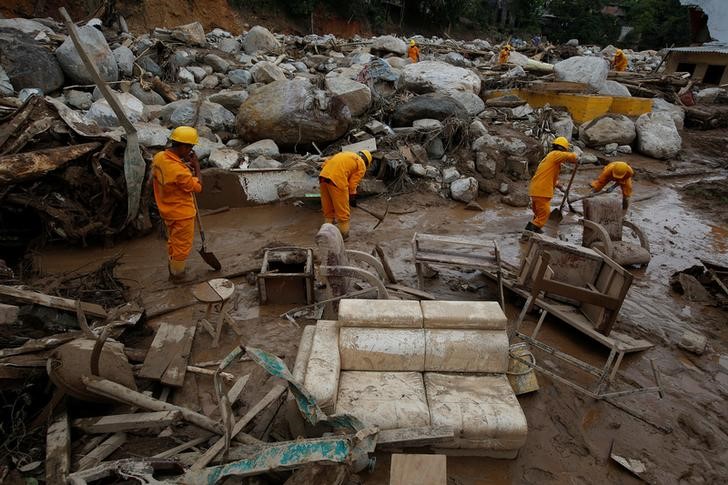Image: Rescuers look for bodies in a destroyed area, after flooding and mudslides caused by heavy rains leading several rivers to overflow, pushing sediment and rocks into buildings and roads, in Mocoa, Colombia April 2, 2017. REUTERS/Jaime Saldarriaga
![]()
MOCOA, Colombia (Reuters) – Scores of decomposing cadavers were being released for burial on Monday as rescuers continued to search for victims of weekend flooding and landslides that devastated a city in southern Colombia, killing at least 262 people.
Desperate families queued for blocks in the heat to search a morgue for loved ones who died when several rivers burst their banks in the early hours of Saturday, sending water, mud and debris crashing down streets and into houses as people slept.
Bodies wrapped in white sheets lay on the concrete floor of the morgue as officials sought to bury them as soon as possible to avoid the spread of disease. The government will begin vaccination against infectious disease on Monday.
“My father’s funeral is planned for this afternoon, but if his body becomes too fetid, we’ll have to do it without the ceremony,” said Maria Helena Benitez, a 50-year-old farming housewife.
The death toll may rise further as rescuers searched with dogs and machinery in the mud-choked rubble.
Many families in Mocoa spent all night digging through the debris with their hands despite a lack of food, clean water and electricity. Only about 45 bodies have been identified so far.
President Juan Manuel Santos, who made a second visit to the area on Sunday, blamed climate change for the disaster, saying Mocoa had received one-third of its usual monthly rain in just one night, causing the rivers to burst their banks.
Others said deforestation in surrounding mountains meant there were few trees to prevent water washing down bare slopes.
More than 500 people were staying in emergency housing and social services had helped 10 lost children find their parents. As many as 43 children were killed.
Families of the dead will receive about $6,400 in aid and the government will cover hospital and funeral costs.
Even in a country where heavy rains, a mountainous landscape and informal construction combine to make landslides a common occurrence, the scale of the Mocoa disaster was daunting compared to recent tragedies, including a 2015 landslide that killed nearly 100 people.
Colombia’s deadliest landslide, the 1985 Armero disaster, killed more than 20,000 people.
Santos urged Colombians to take precautions against flooding and continued rains.
Flooding in Peru last month killed more than 100 people and destroyed infrastructure.
(Reporting by Andres Rojas, Helen Murphy and Luis Jaime Acosta; Editing by James Dalgleish)
Copyright 2017 Thomson Reuters. Click for Restrictions.


